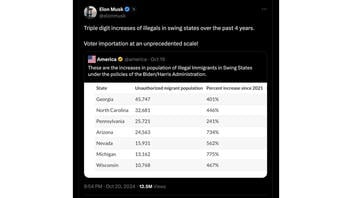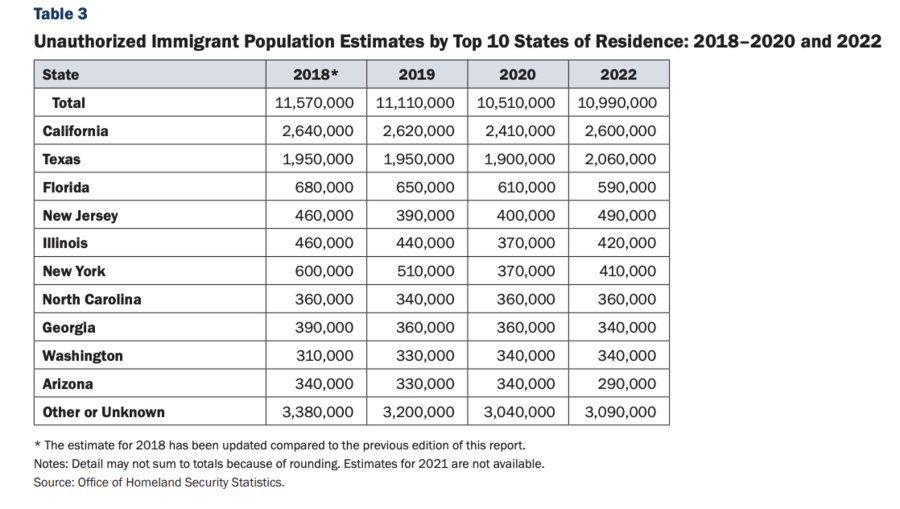
Does a viral post on social media prove that the total size of undocumented populations in seven states has increased by triple-digit percentages between 2021 and 2024? No, that's not true: The chart shared online didn't reflect the correct updated totals and one column referred to court filings in immigration courts, not total populations. Court filing numbers do not represent the overall net growth of the undocumented populations. Estimates from the Office of Homeland Security Statistics and the Pew Research Center point to a far more modest increase or even a decrease in some states.
The claim appeared in a post (archived here) on X, formerly known as Twitter, on October 20, 2024. It opened:
Triple digit increases of illegals in swing states over the past 4 years. Voter importation at an unprecedented scale!
Unauthorized migrant population
Percent increase since 2021
(Source: X screenshot taken on Mon Oct 21 14:23:16 2024 UTC)
The post, published by X's owner Elon Musk, implied that the chart correctly represented the increases of the total size of unauthorized populations in seven states.
The chart came from an August 7, 2024, Market Watch article (archived here) citing the interactive data from government sources published by TRAC (archived here), a project maintained by Syracuse University. The article referred to the chart as "according to court filings," though the exact methodology behind the numerical values and percentage changes wasn't explained.
A TRAC representative told Lead Stories via email on October 21, 2024:
We are not familiar with how Market Watch may have derived these numbers so really are unable to help.
Chris Matthews, the reporter whose name appeared in the Market Watch story's byline, told Lead Stories via email on October 22, 2024:
The data show the number of new immigration court filings, used as a proxy for the number of asylum claimants to have entered a state. The data are not comprehensive, but show directionally where asylum claimants are living.
The most recent data (archived here) on the Office of Homeland Security Statistics website (OHSS) published on April 18, 2024, (archived here) only shows the totals for 2018 through 2022. It offers different figures for the overall size of the undocumented populations, which slightly decreased within that timeframe. Both Georgia and Arizona saw it on the state level, too:
(Source: Ohss.dhs.gov screenshot taken on Mon Oct 21 21:18:25 2024 UTC)
Figures concerning the size of the undocumented population are not based on headcount. Instead they come from estimates that are based on variations of the formula that subtracts people with concrete legal status and naturalized citizens from the size of all foreign-born populations.
That explains the variations (archived here) between different bodies that keep the count, but most tend to agree on the approximate range of 11 million as of 2022.
The Pew Research Center (archived here), which, in 2023, wrote that the U.S. saw the "largest single-year increase in the nation's immigrant population since 2000" of 1.6 million people, spelled out that the cited figure incorporates all categories of foreign-born people, including naturalized citizens and lawful permanent or temporary residents as well as those living without authorization.
In 2022, roughly 23 percent of all foreign-born populations in the U.S. were undocumented. If we apply that to the Pew 2023 increase of 1.6 million to make a rough estimate, the resulting increase will be 368,000 undocumented people.
That would be 3.35 percent of the 2022 OSHH national total, a far cry from the triple-digit percentage increases in the chart of the claim.
Furthermore, according to USA Facts (archived here), which aggregates government statistics, in 2023, six of the seven states in the chart had a lower share of foreign-born populations -- roughly two-thirds of which are not undocumented people -- compared to the national average of roughly 14 percent.
As the Pew Research Center (archived here) pointed out, new arrivals can't be just added to the previous total because "some unauthorized immigrants leave the country every year, some die and some gain lawful status."
The post that is the focus of this fact check referred to new arrivals as "voter importation." But Musk, a naturalized citizen himself, could have known that people are not eligible to vote before becoming citizens, and no process would turn an undocumented person into a citizen overnight. While there are some hypothetical paths to concrete legal status (archived here), they all involve years of wait time (archived here) and if those petitions are approved, a person would have to wait three or five years more to become eligible for naturalization. That's a separate petition whose processing, as of this writing, takes around seven months, according to U.S. Citizenship and Immigration Services.
This portion of the claim recycled an old, debunked narrative about the purported mass voting of non-citizens in federal elections. The available data shows that such cases are exceptionally rare (archived here) and are not capable of altering an outcome.
Additionally, Bloomberg (archived here) found that two-thirds of asylum seekers who came to the U.S. in 2023 and went to the 2024 election swing states chose the counties that voted for the Democratic candidate in the 2020 election. While this is one group that might theoretically become eligible to vote due to approval of their petitions and subsequent naturalization at some point in the future, the existing distribution of this population doesn't appear to be a major factor that would singlehandedly turn red counties into blue. This is contrary to what Musk wrote on September 29, 2024.
Other Lead Stories fact checks of the claims mentioning immigration can be found here. Stories concerning the 2024 U.S. presidential election are here.


















